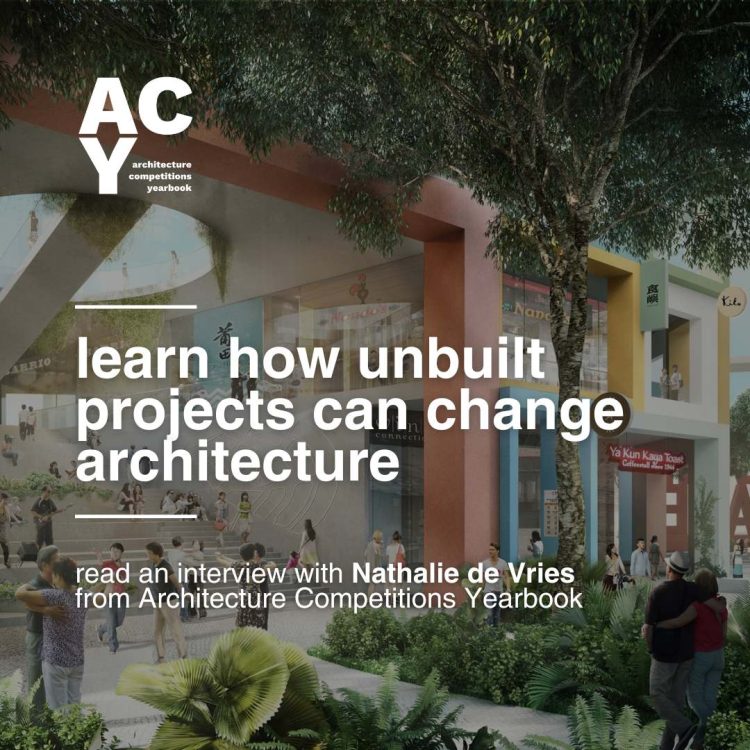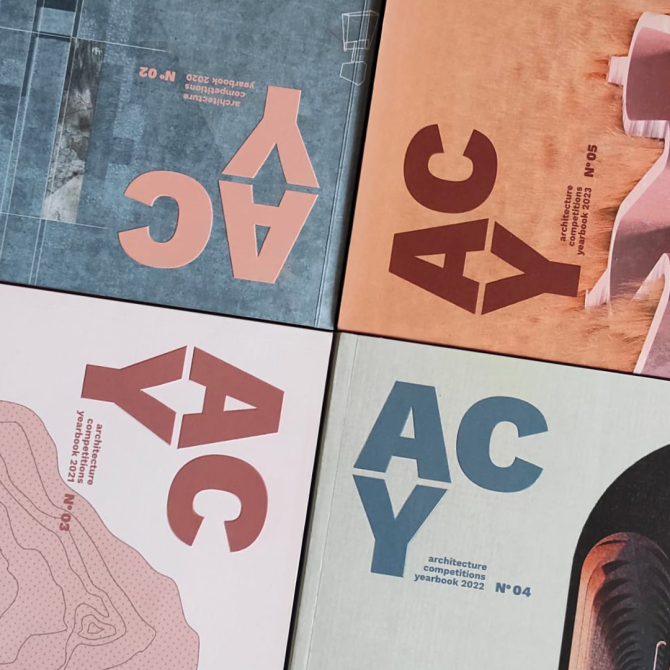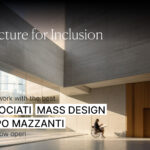Can unbuilt projects change architecture?
Nathalie de Vries’s take on competitions, utopian futures they represent and why they remind her of a pressure cooker.
CA: Natalie, please tell me a few words about yourself.
Nathalie de Vries: I’m an architect and an urbanist from the Netherlands, educated in Delft. Soon after I graduated, I started my own office by winning a competition. With my, still, partners we won a European competition in Berlin so we were quite young. We didn’t have an office at that time, but people thought we were an office, so from that moment alone we started to look at ourselves also as an office.
Is winning a competitio n a good time to start your own office?
After our graduation we started working for other offices, but of course we soon discovered we also wanted to do something that really came from ourselves and not for the employers we were working for. And we thought competitions are a wonderful way to explore our own ideas further and have a little freedom in what to do.

What was the first competition you took part in?
I think I took part in competitions as a student. One of the first was with my now husband, but it didn’t work out that well [laugh]. We were also quarrelling a lot. So you could say that theEuropean Competition was the first serious competition we did with a third partner, and that proved to be the magic formula. Why were we so interested in that competition? Because we had to figure out new ways of living in the city. The European [Competition] is dedicated to housing and the development of the cities and we really saw it as a nice platform to investigate and show our ideas.
What are the benefits of taking part in architecture competitions?
In a good competition everybody has the same chances, the same opportunities. And if a lot is asked for, we also think it should be fair that the competitions are paid for, especially invited competitions. Also the uninvited ones are an excellent possibility for young architects, who are not that well known, to gain a platform. Looking at the results you can also always learn about yourself and about others. I would also say it gives a sort of indication of what’s going on in contemporary architecture, when you look at the results of a competition.

Is there any specific design process you follow when starting a new project?
I wish there would be a magic formula on how to participate in a competition, so you always win. I think the best ones are when you are able to actually go to the site. Or when it’s hypothetical, that it sort of continues themes that you are already working on. I would say participating in a competition makes it possible to explore ideas and to really make a statement. So it is important when you work on a competition, we think, is that we make up design that really communicates an idea. It’s always a lot of pleasure to see the finished project, to have these panels or boards or just this sort of one project in an overview. So that’s the fun part I would say – because if you win and it will be built, many hard years will follow. Competition has something artificial about it as well – it’s like it pretends that you can have a perfect idea in a couple of weeks or months. So that’s also something about a competition – you can try something, but you know reality will come as well. When you build – a lot of the projects we make are also a long dialog with the site, with the money, with the budget, with structural issues. It’s a hyperdense format. Like a pressure cooker way of thinking about architecture.
Are there any differences between the regular projects you work on and the projects you prepare for architecture competitions?
I’d say in competitions the projects are often a bit more sharp and extreme, and outspoken, because there’s less dialog watering down things. On the other hand if you have a direct under commission – after the conversation with the client unexpected things can happen…. I’ve never thought about it, if you’re just working in isolation.
Can unbuilt projects change architecture?
I mean I’m looking here at this magazine and seeing something I’m thinking that I don’t know what client would answer this, if only they would… So I think competitions can bring us to dreams, futures, show something like a utopian vision of the future as well. A good competition, I think… I remember competition designs for Park La Villette, that was during my study years. We all just looked at different solutions that the architects had made for that competition and they informed us in so many different ways, also the ones that were not built. Because they can be so strong and powerful, they can still have an influence. I mean, our first competition design together for Berlin Voids Project was never built, but it still plays an important role in our own architectural language. It was the kickoff point, that assembled many of the ideas we had together. So also unbuilt projects can change architecture that is built.

If you had the chance to start your architecture career again, is there anything you would change?
I think I wouldn’t change a thing, because I think when you’re young you just go for it and think ‘this is it, this has to be done’. Now, I’m thinking maybe twice or three times. I’m thinking a lot about things and at that time we just went for it. I think that’s good as well. I mean competitions are also out there to explore possibilities.
What’s the role of an architect in contemporary society?
Architecture has always been an integrative profession. We include many aspects of design. You know: cultural, technical, societal. I think in an era, where more and more things get specialized, it’s very interesting as an architect to remain this generalist person, who actually thinks about how things could come together. Because if you want to do good quality architecture, good quality environments, cities, if you want to change the way we build, that’s something we have to do in the future. A lot of aspects of design have to be coordinated and brought into, and translated into buildings. So I think our general outlook and our genericness in what we can do is a very important quality to use these days. So we don’t go in one or in another direction.
How does the internet/social media impact architecture?
I think information about architecture is going around the world like that [snaps her fingers] right now. Because in the past we had a publication, and one year from the first publication in the Netherlands it would probably be somewhere in Korea. Now everything is online and everything is available for everyone instantly. I think there’s much more dialogue in general about architecture. The community therefore almost gets smaller and bigger at the same time, news spread fast. I hope it helps everybody to learn from the best examples.
Is the design process different now, as opposed to 20-30 years ago?
I do notice that certain styles and fashions are spreading fast. I see it sometimes in the office: things popping up and at the same time with students as well. And then you know that everybody saw the same thing. But I guess at the same time the amount of influences grew so much, I’m not sure if it’s any different from 20 years ago, when the international magazine got to everybody’s doormat or whether you see things online. In the end, architecture is a slow profession. In the end I always say it has to get built and someday you will be confronted with the real thing. So, whatever means you use to get there; I like that digitalization helps to integrate much more teamwork – that is also part of the architect’s building information management. Scripting all these tools enriches our lives so much.
See the interview with Natalie on YouTube:

Nathalie de Vries
A co-founder and principal architect and urban designer of MVRDV, an interdisciplinary studio that works at the intersection of architecture and urbanism. Together with co-founder, Jacob van Rijs she has published MVRDV Buildings (2013), about the post-occupancy and the making of the built work of MVRDV.
De Vries has created a diverse body of work in a variety of scales and typologies that are grounded in connecting individuals, communities and environments. Her approach has resulted in much acclaimed projects that activate their contexts, public spaces and communities. Over the past 25 years she has designed and realised Dutch projects such as Villa VPRO, Silodam Housing, and the Spijkenisse Library as well and the masterplans for Nieuw Leyden and Westerpark West in Amsterdam, the Netherlands. Recent projects include the award winning Baltyk office Tower in Poland, as well as office projects in Łódź, Shanghai, and Colombo, housing projects in Rennes, France, San Francisco, USA and Amsterdam, the Netherlands.
In addition to her work for MVRDV, De Vries engages as Professor of Architectural Design at Delft University of Technology. Between 2015-2019 she was president of the Royal Institute of Dutch Architects BNA. She regularly lectures at renowned universities and engages in international juries.
If you would like to ready more case studies like the one above please check our annual publication
Architecture Competitions Yearbook.









